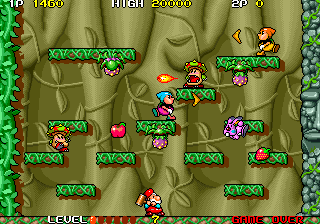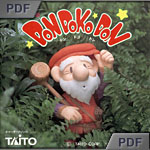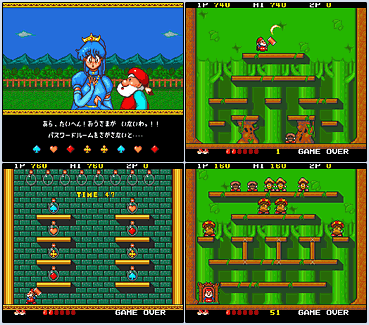|

|

|
|
ドンドコドン
©Taito Corp. 1990
Release : 1990-05-31 (¥5800)
Hucard (3 Mbits) TP02010
Action / Puzzle game
|
Don Doko Don is a cute platform game by Taito and conversion of the
arcade game of the same name originally released in 1989. The kingdom of
Marry Land is in sadness and sorrow - the beloved princess has been
kidnaped by a mysterious king cow.
She is now imprisoned in the dreaded Dragon castle and two courageous dwarves
(Bob and Jim) decide to leave their native forest and to embark on
a journey to save the young damsel. In a way similar to other classics at the time
(such as Bubble Bobble), each level is single-screen in size and is filled
with hordes of relentless monsters. The goal of the game is clean and simple - players
must defeat all the enemies in sight within a time limit in order to move to the next
level. And in Don Doko Don, they use large mallets to smash them flat before
sending them bouncing around the screen. Alternately, stunned
enemies can also be carried around and thrown against walls or other enemies. But
the critters are tougher than they look and regain consciousness after a short
period of time, and the dwarves must hurry and finish them off before they get a chance
to jolt awake. Defeated enemies drop all kind of valuable items that the player can
collect for extra rewards (some items randomly appear during gameplay).
Although most of them are fruits that award bonus points,
some upgrade the player in various ways, such as speed-ups (blue potion),
throwable blue hammers, crushing grey hammers and other items that kill
all monsters in one blow, make stars rain from the sky or increase the player's power
level (Red Potions or P icons). This is another very important aspect
to Don Doko Don - each dwarf comes with a power level (displayed at the
bottom of the screen) that represents how many enemies can be disposed
at once. When full, the power level flashes and indicates that the player can throw
enemies through anything, even walls! This level however decreases each time the
player receives a hit from a projectile or collects a rotten (spotted) fruit.
Don Doko Don consists of five different themed worlds (made out of ten sub-stages each)
and also features a two-simultaneous player mode.
|
 Don Doko Don was originally released in the arcades in 1989 (picture on the right)
and was ported
to the Famicom (1990), the PC Engine (1990) and was also later included
in the Taito Legends 2 compilation released in 2006 (Playstation 2, XBox
and PC). A sequel, simply called Don Doko Don 2, was exclusively
released for the Famicom system in 1992. However, the game follows a
different formula than its predecessor and is a side-scroller at heart. Although
Don Doko Don is an old and seemingly forgotten franchise, the bearded
dwarves made a few cameo appearances in several Taito games, such as
Bubble Symphony (Arcade,1994 and Sega Saturn,1997) and
Pop'n Pop (Arcade,1997, Playstation,1999 and
Game Boy Color,2001).
Don Doko Don was originally released in the arcades in 1989 (picture on the right)
and was ported
to the Famicom (1990), the PC Engine (1990) and was also later included
in the Taito Legends 2 compilation released in 2006 (Playstation 2, XBox
and PC). A sequel, simply called Don Doko Don 2, was exclusively
released for the Famicom system in 1992. However, the game follows a
different formula than its predecessor and is a side-scroller at heart. Although
Don Doko Don is an old and seemingly forgotten franchise, the bearded
dwarves made a few cameo appearances in several Taito games, such as
Bubble Symphony (Arcade,1994 and Sega Saturn,1997) and
Pop'n Pop (Arcade,1997, Playstation,1999 and
Game Boy Color,2001).
|
|
This port of Don Doko Don is really faithful to the original arcade game,
and the differences are minor. Firstly, some visual effects (such as zoom or sprite
distortion and rotation) were obviously omitted - for instance some levels appear
with basic zoom effects and some bosses (such as the pumpkin boss) use excellent
rotation effects. Finally, when players complete the arcade game, the princess
mentions that the king is still missing. This part is also present in the
PC Engine version, however the way to find him is slightly different.
In the arcade game, the player must hit and break an hidden crystal in the first
level, collect a key and unlock a magic door to access a Secret Room.
There, another crystal releases a second key, and a new hidden door that leads
to a Password Room where the player can enter a special code to access
the Reverse Rounds (it seems that this code is given away after
collecting four crystals throughout the game, all hidden inside different
Secret Rooms). In The PC Engine version, the Secret Rooms
were apparently omitted and the first magic door leads directly to the
Password Room (see the 'Secrets' section below).
Finally, the end credits list all the enemies in
the arcade game whereas the PC Engine version only features a staff roll.
|
Game Staff (Copied from the end credits) :
|
STAFF
Producer
Ojamamushi
S. Kawakami
Director
Hatabou
|
|
Character
Y. Takasu
Sound
Waiwai
Y. Watanabe
K. Dekune
|
|
Programer
K. Sasaki
S. Tajima
|
|
Thanks
K. Onsen
M. Mizuno
T. Narita
Presented by
Taito
|
|
O
M
A
K
E
|
|

|
|
|
Click on picture to enlarge |
S
E
C
R
E
T
S
|
|
 Reverse Rounds:
Reverse Rounds:
When you complete the game, the princess says that the king is missing and
gives you a code. To use it, start the game and, in the first level, jump to
the highest platform and swing your hammer while jumping (you have to stand in
the middle of the platform). The outline of a spherical crystal should
appear - keep hitting it until the crystal breaks into pieces. This action
releases a key that opens a magic door. Open the door to access a special
hidden room - there, eight jars with four different signs appear and you
have fifty seconds to enter the password the princess gave you (namely
Spade, Heart, Diamond, Club, Club,
Spade, Heart and Diamond). This gives access to fifty
new (rearranged and harder) levels called the 'Reverse Rounds'. As a side note,
these levels have a new final boss - once the dragon is vanquished, the evil
king cow appears and must be defeated! Additionally, this epic final battle
unlocks the true ending of the game.
|
|
|
|
LK

|
|
Add your Pov here !
|
P
O
V
s
|
|
Don Doko Don is an excellent conversion and a really fun game overall.
It starts out as a fairly harmless action/platform game - you're not sure
what to do at first and it takes a couple of minutes to learn the game's
inner mechanics and controls... but it quickly becomes extremely fun to toss
enemies against walls and turn them into bananas and other colorful fruits.
All of this accompanied by a catchy soundtrack and excellent graphics. But I
have to give a special mention to Don Doko Don's level design. Each
area is punctuated by its own unique features - icy platforms, falling rocks,
rotating windmills - and some are really nice and very unusual, such as the
crystal blocks in later stages that you can destroy with your mallet, and
which stack up as they fall. The two-player mode is the icing on the cake
and is a great addition to an already fine game. All in all, Don Doko Don
doesn't have as many hidden secrets and appealling gameplay as other Taito games
from the era (such as the classic Bubble Bobble), but it is without a
question an excellent game and an incredibly faithful port.
|
|
|
|